THE REAL 1980s SHOCK TROOPS OF THE SOVIET ARMY – PART II
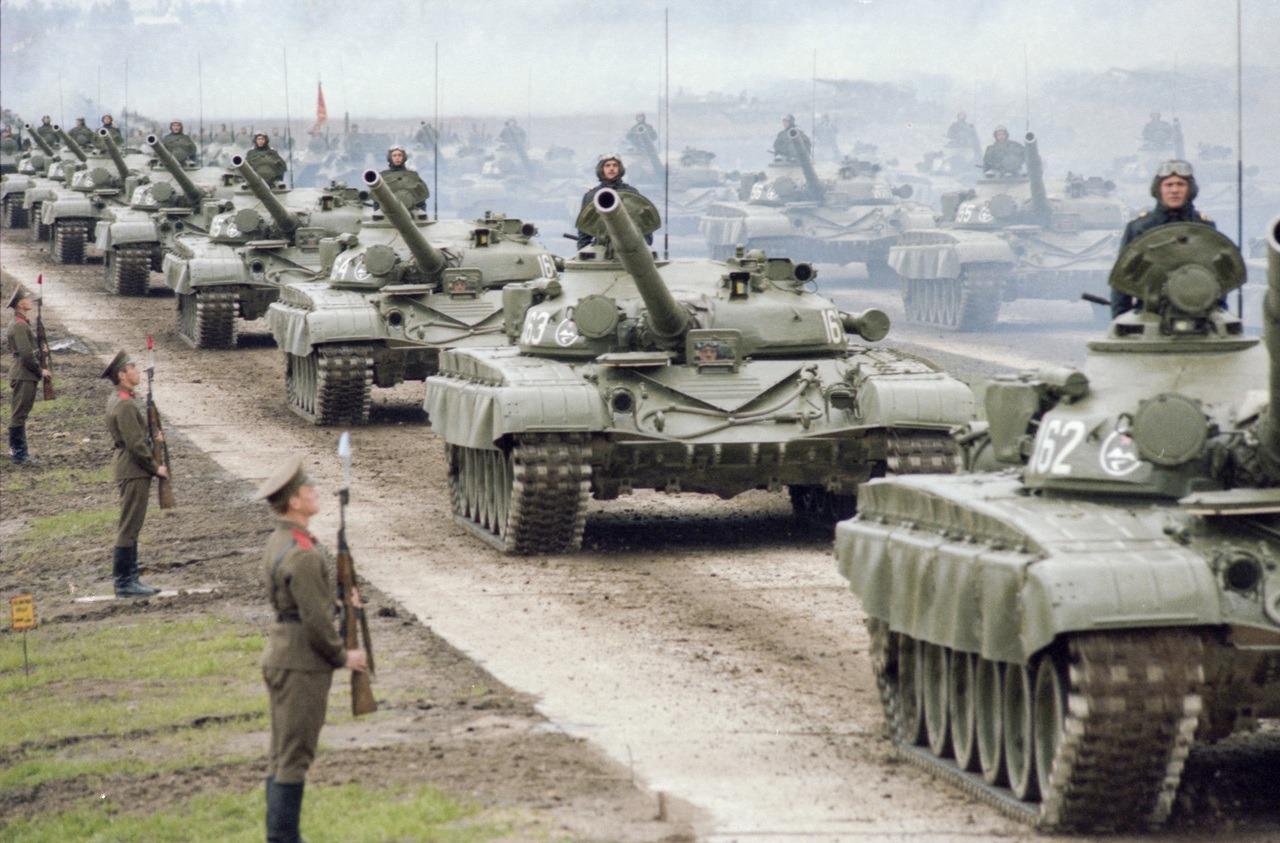
By Jim Naughton
When I originally contemplated writing this article, data points were hard to find. But BF’s expansion of the game has added additional data beyond the original unit in WWIII TY Soviets.
In RED DAWN we find ‘VDV’ and ‘VDV Afghantsy’ units, the first being a battalion with improved skills and assault ratings and the second being veteran paratroopers with NATO-like ratings.
From NORDIC FORCES we find Finnish troops using (mostly) Soviet gear with ratings like the VDV Afghantsy companies.
Estimating an AP value for the ‘REAL SHOCK TROOPS’ became less guesswork and more scientific.
With that observation, let’s start with the Independent Border Screening Regiments, or SHOCK T64s.
SHOCK T64s
The Border Screening Regiment transitioned from odds-and-ends to superior units 1979-80 as they gained headquarters, support and real missions beyond blocking NATO penetration of the IGB. From my reading, they most closely imitate the image in SOVIET FORCES – they were encouraged to study and use NATO tactics. From 1983, they were equipped with T64s.
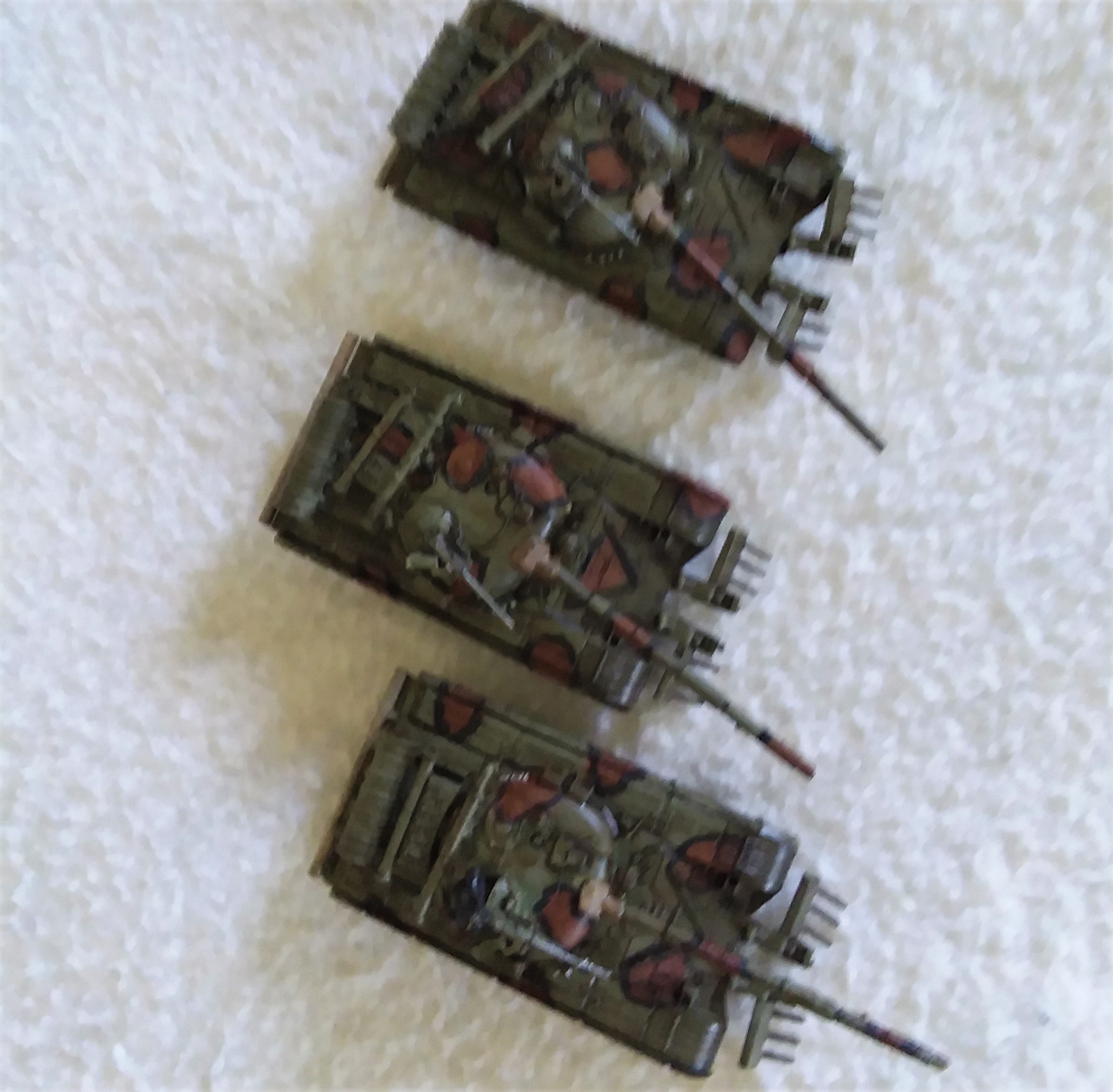
The Shock T80 organization chart found at pg. 53 of SOVIET FORCES works well for this organization, with a couple changes. Obviously, the tanks change to T64s/T64BVs. During the 1980s these units did not have KOBRA (AT-8 SONGSTER) missiles. Had the WARSAW PACT survived to 1995, it’s likely they would have been further upgraded.
It is also known that these units did not use BMP-2 or BMP-3 in 1985, so a Shock BMP-1 needs to be introduced. Also, by 1985 these would be BMP-1P with the capability to switch between SPIGOT and SPANDREL missiles. See my article A BMP for ALL SEASONS for a description of this vehicle.

The regimental artillery would be 2S3, not 2S1. See Figure 1.
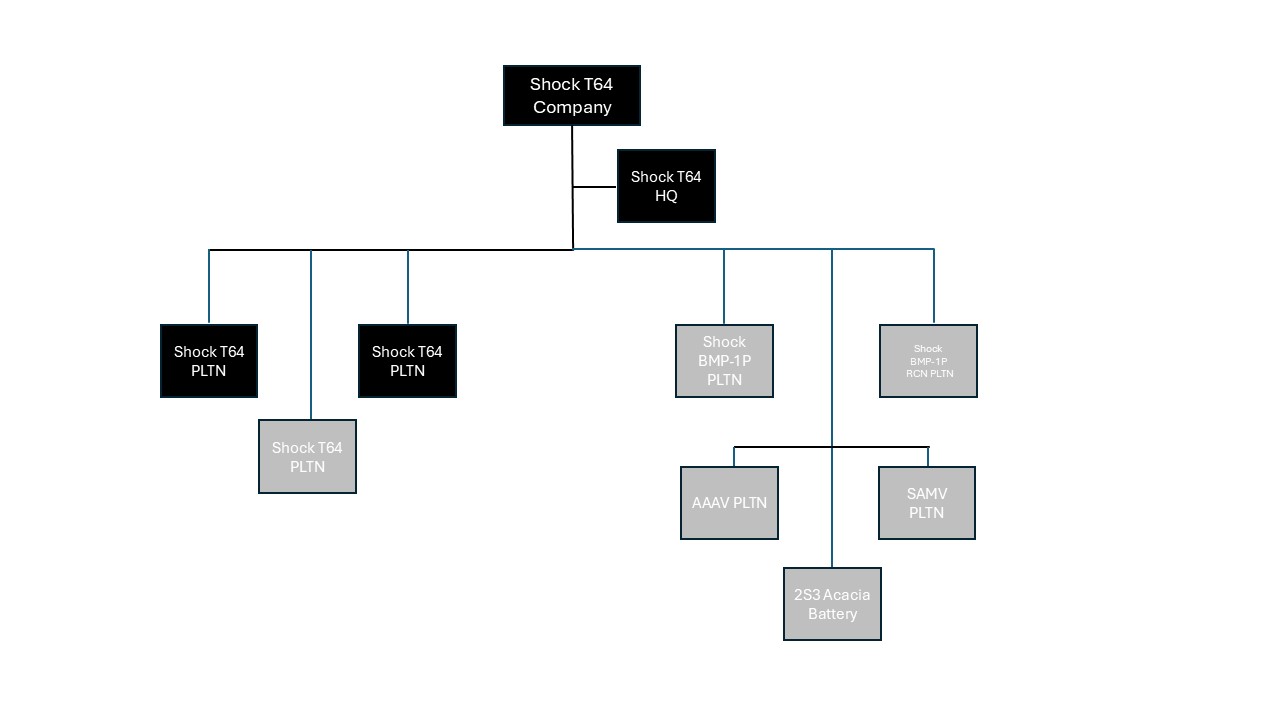
SOVIET FORCES shows a 30% AP increase going from three T80s to three Shock T80s. This is reflected in Table 1 entries for T64 and T64BV.
BMP-1P platoons require more thinking. There are several data points to examine. First, the Shock Company in SOVIET FORCES (pg. 55) allows the downgrading from BMP-3 to BMP-2 at -3AP. These companies are compelled to take RPG-7VR which normally costs 2AP. So ‘Shock’ BMP-2s without 7VR should cost 10 AP. This is a 25% increase over the ‘small’ Soviet BMP-2 company. However, a platoon has only 3 vehicles in its organization. Adding one vehicle and one infantry stand to a shock BMP-2 company costs 3AP. Giving a final price (by analogy) of 7AP for ‘Shock’ BMP-1 with three tracks.
The Finnish Jaakari Platoon (pg. 22-23, NORDIC FORCES) offers another insight. The Finnish assault skill is 3+, theoretically making them more valuable. A platoon with three BMP-1s and no missiles costs 6AP and the SPIGOT missiles add 1AP, giving 7AP for a unit with BMP-1Ps (even if BF doesn’t name them such).
The final clue is BMD-1 ‘Afghantsy’ (pg. 21, RED DAWN). The platoon has similar skills to the Finns and costs 8AP. It also can have attachments with transport at 1AP each – PKM, AGS-17 and SA-14. It upgrades to BMD-2 for 1AP and adds 7VR for 1AP.
From these analogies I recommend 7 AP for a platoon of BMP-1P (with SPIGOT) or BMP-1 with three vehicles and six infantry teams. Upgrading BMP-1P with SPANDREL should cost 2 AP for the unit as I recommended in BMP for ALL SEASONS last year. The augmentations (AGS-17, GREMLIN, 7VR, PKM) should cost 1 AP.
The BMP recon element would be BMP-1P as well and given analogies to Finnish BMP-2 and the Shock BMP-3 platoon, four points seems right for three Shock BMP-1P with SPIGOT. Table 1 gives the calculated values and recommended soft skills for the Shock T64 company.
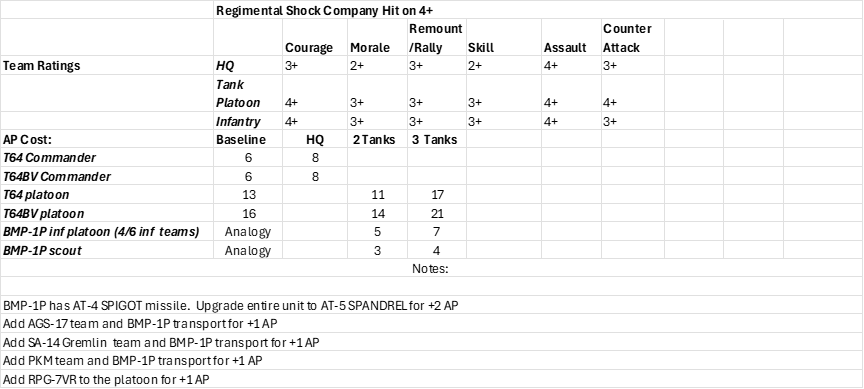
Geroy T55 – Tank Brigades in the GSFG
The conversion of the two tank training regiments into brigades would have required additional manpower (particularly for infantry). While the cadres would have been more experienced than typical Soviet units, it’s doubtful that the resulting units would have the full set of skills found in the original Shock T80 company or what I’ve recommended for the independent regiments.
Creating a whole new class of unit. These would be like VDV units found in RED DAWN, i.e. the building block would be the company. The experienced cadre could influence the soft skills somewhat. But the big difference between those two units – ‘IS HIT ON’ – represents an individual team’s tactical awareness. These units, like VDV BMD, should retain the 3+ To-Hit characteristic and be organized by battalions. And include a variety of tanks, including T55.
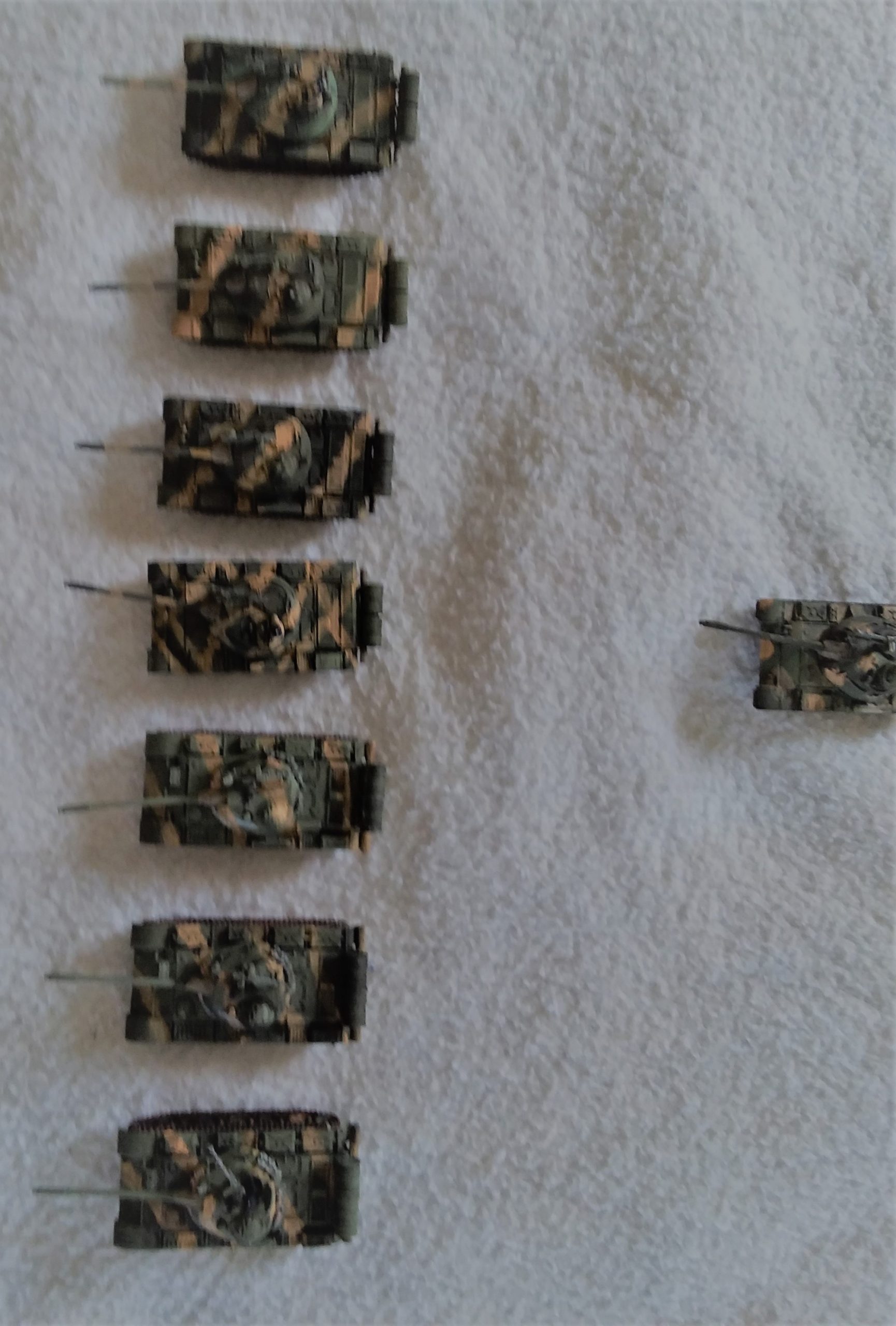
To distinguish between this class of units and Shock units, I’ll borrow from Flames of War and call them ‘Geroy’ (Hero) battalions.
The ‘official’ tank brigade Table of Organization and Equipment (TOE) called for five companies in each battalion, requiring augmentation of a standard tank battalion by two additional companies. Given the mix of vehicles found in the GSFG’s tank training regiments, this likely would result in mixed tank battalions as found in the Great Patriotic War. So the TOE displayed at Figure 2 requires two companies of T55AM and gives three additional companies, of which two can be newer tanks. The BMP company is BMP-1Ps.
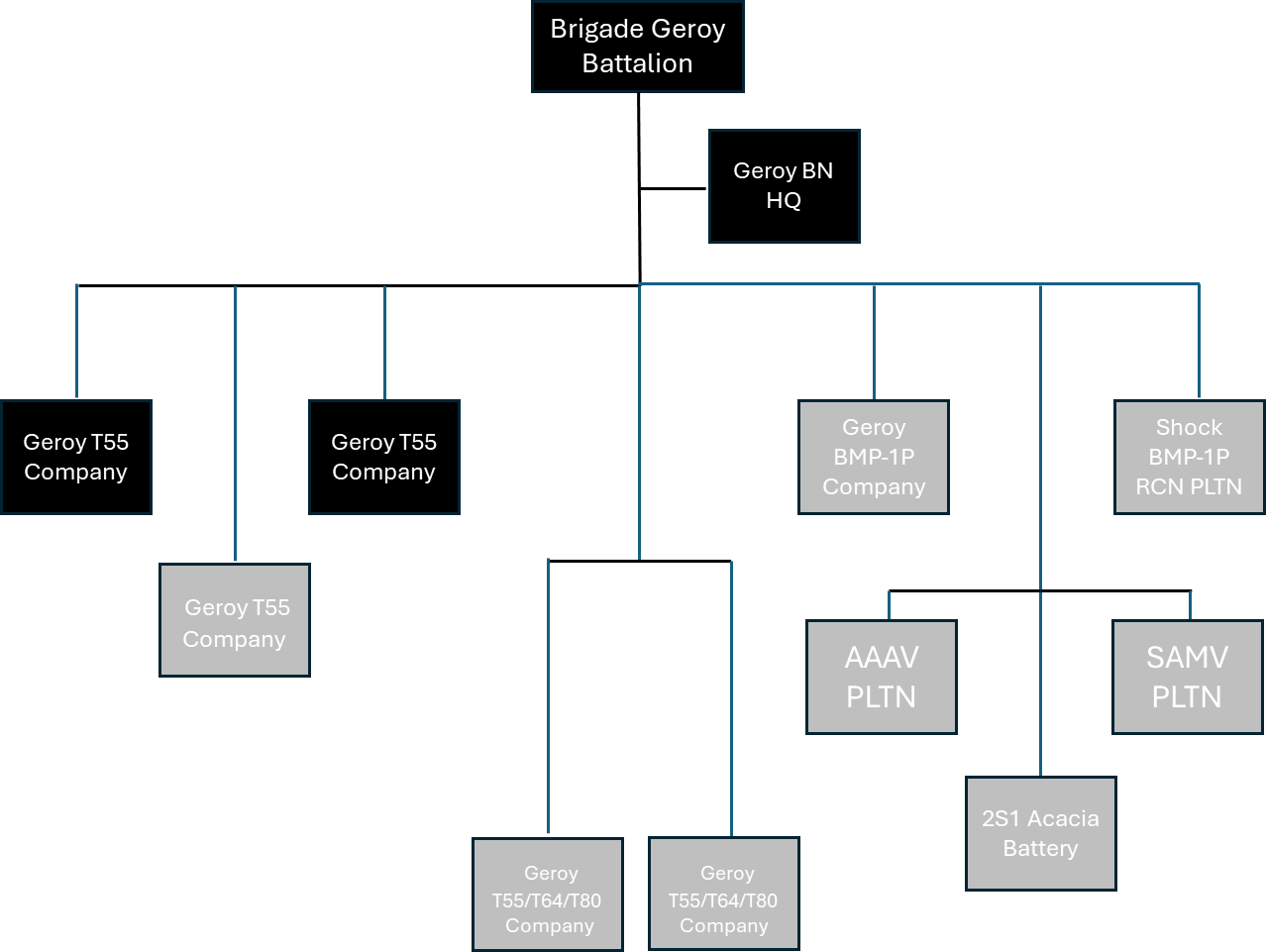
I estimated the added cost of ‘Geroy’ units using the VDV BMD Company. The BMD-1 company costs 1AP extra for the basic ‘small’ company compared to the ‘small’ BMP-1 company. At the medium company entry, the BMD-1 company (with two added PKM/AGS teams in BTR-D) is 2AP more than the medium BMP-1 company (which has two built-in machinegun teams).
Large company, 3AP. But the medium BMD-2 company (with two added teams as the BMD-1 medium company) is the same as the BMP-2 medium company. At the large company we see a 2AP ‘bump.’ Considering the large number of teams (15-24) found in the medium and large BMP/BMD units, it seems safe to conclude that 1 AP is the right adjustment for small ‘Geroy’ BMP units and tank companies, while 2 AP would cover the medium and large ‘Geroy’ BMP units. See Table 2.
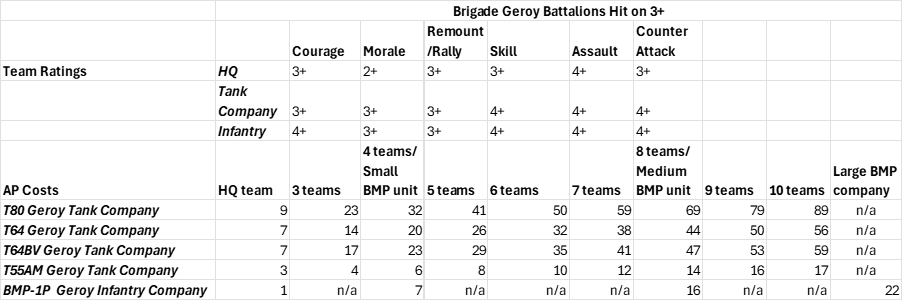
The source of other tanks brigades in the Western TVD (or tank regiments, for that matter) was activating portions of CAT B and CAT C units. Some of these units might be training units, but most would not. The reader is left to choose.
Shock/Geroy T72 and T62 – The Great Experiment – Combined Arms Battalions
As mentioned in Part I, the Soviets created two new units from existing divisions. The experiment started in 1980, leading to new titles in 1982. These two units were the 5th Guards Tank Division in Kyakhta near the Mongolian border and the 120th Guards Motor Rifle Division in Minsk.
To test the new formations these units STAVKA approved additional equipment and intensive training.
The 120th MRD (Rogachev Guards) was a high-priority CATEGORY B unit even in the ‘70s and was completely equipped with T72As and BMPs (no BTRs) by 1980. It figured prominently in exercises and demonstrations even before its designation as the 5th Combined Arms Corps (CAC) in 1983. (Some sources name this the 5th Guards CAC.)
Because it already had over 250 tanks and nearly 500 BMPs it was a natural for this new mission. It added another 200 brand-new T72s, presumably T72B, over the next year. The new organization had many new wrinkles, including regimental BM-21-1 (36 launch tubes instead of 40) batteries, SA-8 Geckos in the regiments, SA-11 (not yet in game) in the Corps ADA battalion, BM-27s in the Corps Rocket Artillery.
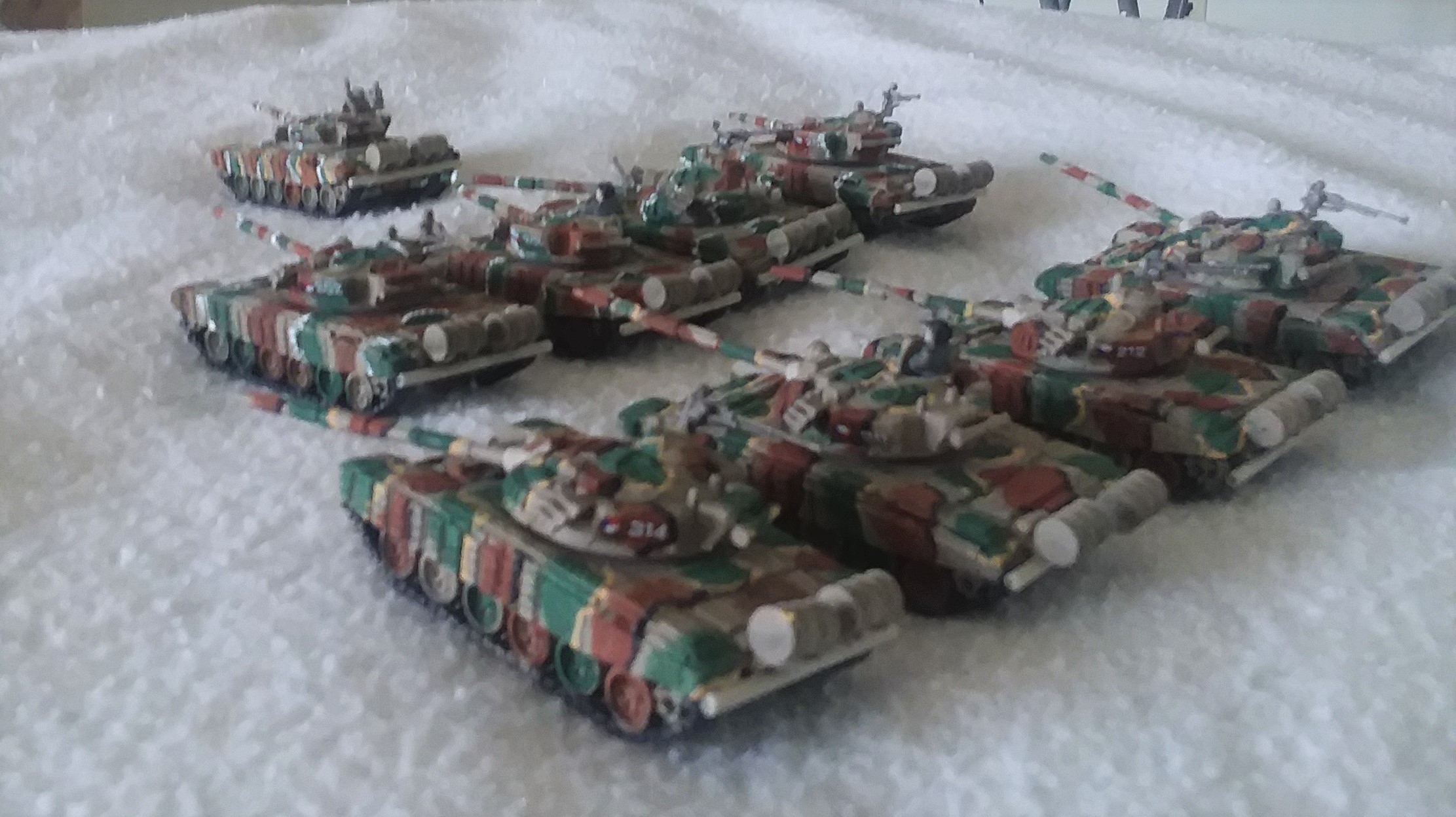
From 1983 until 1988 when Gorbachev’s ‘Sufficiency not Superiority’ mantra led to STAVKA to revert to the previous TOE, the 5th CAC’s training exceeded Soviet norms, concentrating on combined arms tactics at the company and battalion level. The former regiments became Guards Tank Brigades and Guards Mechanized Brigades and each included at least two Combined Arms (CA) battalions containing as many as five companies. In turn, these battalions operated mixed company teams in a NATO-like manner. The CIA described the CA Battalions as ‘armored cavalry squadrons.’
So the ex-Rogachev Guards were strong candidates for Shock status and shoe-ins for Geroy status…in their T72A/Bs. They retained these tanks until joining the Belarus military.
This unit had differences from the standard RED BANNER units. The most noticeable was the Combined Arms Battalion. Figure 4 depicts how the Combined Arms Battalion should be represented as a Geroy Formation in TEAM YANKEE. This formation has options for up to six companies but the norm was four or five. The Battalion HQ vehicle would normally be the same as the most numerous company.
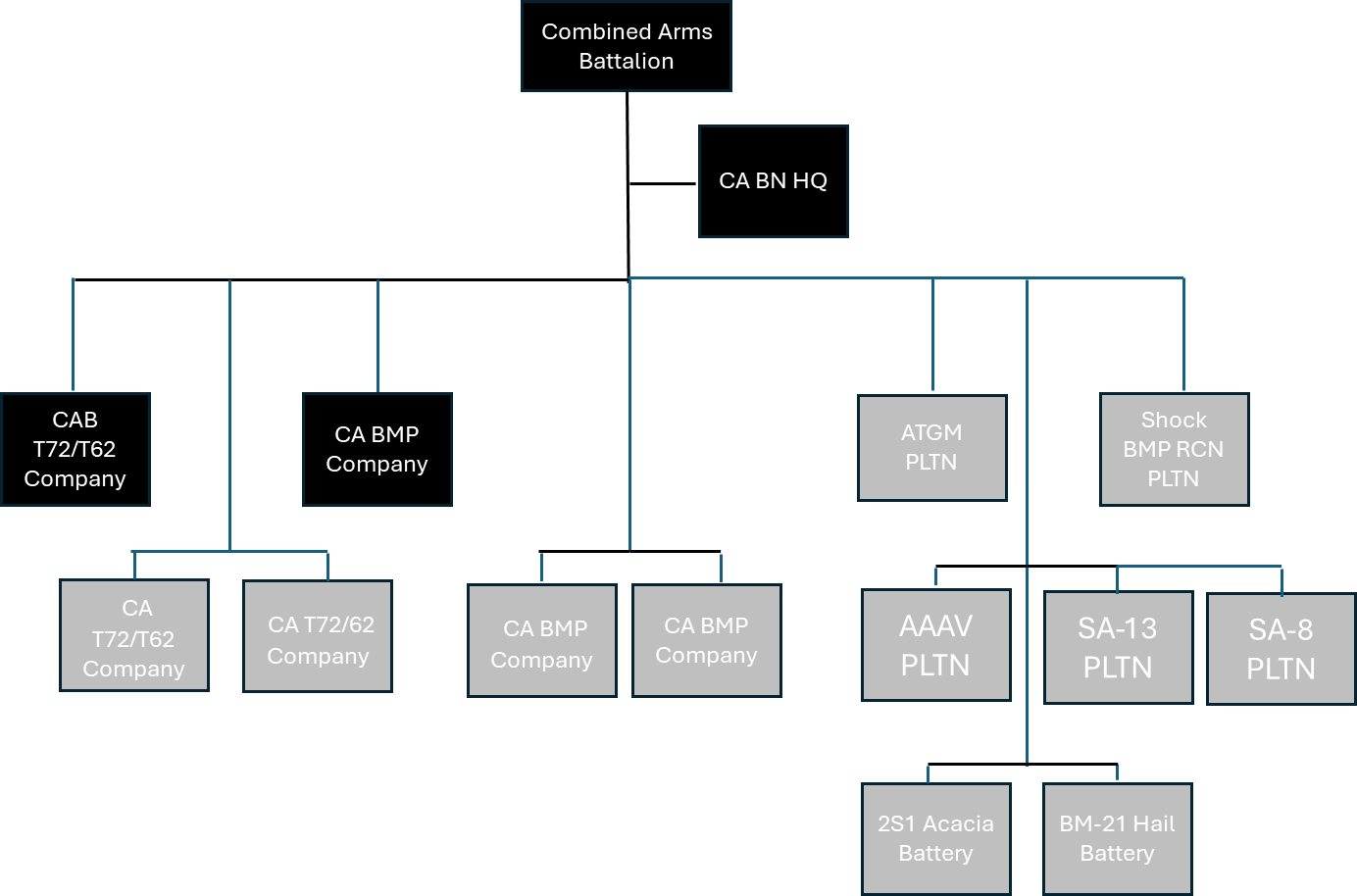
Note that there were enough BM-21s and SA-8 Geckos in each brigade that they show up in the battalion.
Figure 5 shows a Shock Company derived from this Corps. The Shock Combined Arms Company differs from the Shock T64 above and the Shock T80 company by having up to six platoons. Like the Combined Arms Battalion, the norm was four or five platoons at various times in the six-year period these units existed. The HQ was normally furnished by the most numerous platoon.

Two major differences existed with the 48th Guards CAC. They started with T62s and a tank division as the base formation. Stationed on the Mongolian border, it began its transition at the same time the USSR started its upgrade project for T62s. Beginning with 328 T62s it acquired roughly 150 more over the course of 18 months. More challenging was adding 300 BMPs and barracks for additional infantry companies.
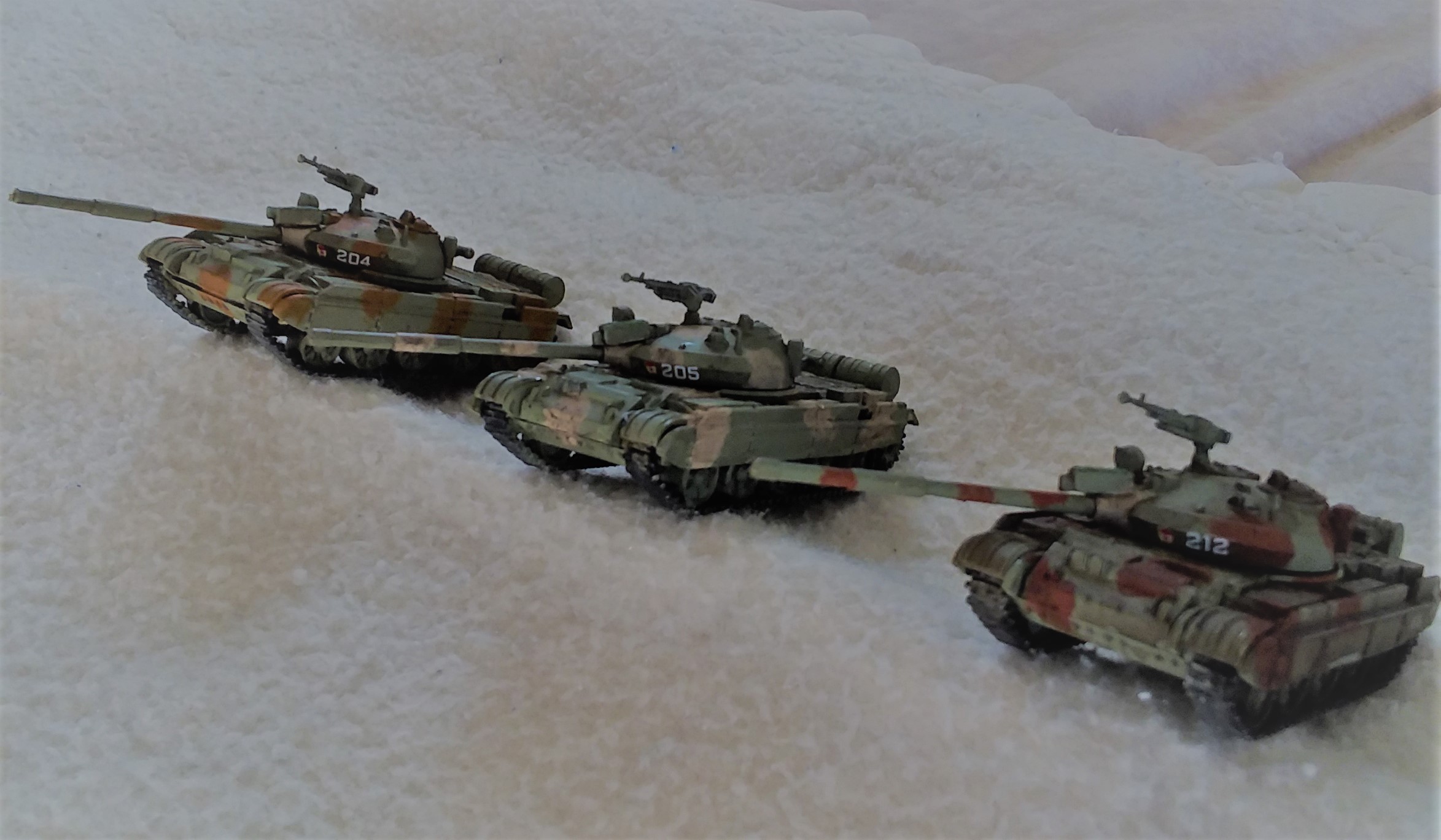
While casual thinking would place this unit outside of the Western Theater of Operations (TVD), the 48th Guards was a STAVKA asset and would go where the war was. Ralph Peters gives it a prominent place in his Red Army novel, and that reflected NATO’s expectations.
Like the Border Screening Regiments it stayed with BMP-1P throughout, but by 1987 was replacing its T62Ms with T72 (presumably B).
Table 3 gives values for Shock Companies and Table 4 gives values for Geroy Battalions of these two formations. I’ve included both to account for special training in the Combined Arms battalions to form Forward Detachments.

I’ve included BMP-2 and BMP-3 in Tables 3 and 4. This is because the 5th CAC replaced its BMP-1s with BMP-2s and had the Cold War continued, the 48th Guards CAC would have followed suit. Eventually they would have used some BMP-3s.

Note that Table 3 includes options for a fourth tank in the tank platoons and Table 4 includes options for 11-13 teams in the tank companies, as found in Motor Rifle Regiments.
Support
In the charts, I’ve carefully been vague about some of the support units. Two reasons for this. First, these units evolved over the decade and so ZSU-23 would migrate into TUNGUSKA eventually, and the screening regiments could have either SA-9 or SA-13.
The second reason is that support units could have greater skill simply through the training regimen that the parent regiments experienced. So for +1 AP to the unit, artillery units can receive the ‘soft’ ratings of the NONA, ATGM the ‘soft’ ratings of the BTR-RD, and antiaircraft units the ‘soft’ ratings of the BTR-ZD. This would apply to units on the FORCE diagram if the FORCE included at least one Shock/Geroy Formation. See Table 5.

Conclusion
I’ve catalogued three types of units that were trained beyond Soviet norms. These three units could be treated as ‘Shock’ formations. I’ve suggested a lesser status, which I call ‘Geroy’ (Hero) corresponding to the split between VDV and VDV Afghantsy. And I’ve presented unit capabilities for these troops that can be used in casual gaming.
The most important thing to remember is that ‘Shock’ status wasn’t purely a province of T80 units.
As a footnote, I’ve deliberately stayed away from Dynamic Points. This is because the numbers haven’t stopped dancing. You can use the guidelines I’ve presented to make your own numbers under dynamic points.
